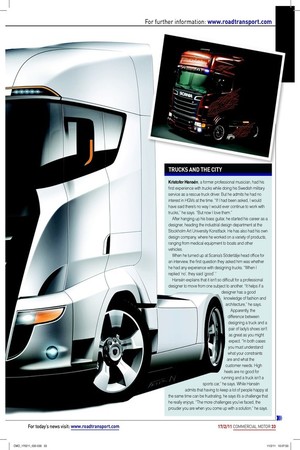TRUCKS AND THE CITY
Page 26

If you've noticed an error in this article please click here to report it so we can fix it.
Kristofer Hansén, a former professional musician, had his first experience with trucks while doing his Swedish military service as a rescue truck driver. But he admits he had no interest in HGVs at the time. “If I had been asked, I would have said there’s no way I would ever continue to work with trucks,” he says. “But now I love them.”
After hanging up his bass guitar, he started his career as a designer, heading the industrial design department at the Stockholm Art University Konstfack. He has also had his own design company, where he worked on a variety of products, ranging from medical equipment to boats and other vehicles.
When he turned up at Scania’s Södertälje head office for an interview, the first question they asked him was whether he had any experience with designing trucks. “When I replied ‘no’, they said ‘good’.” Hansén explains that it isn’t so difficult for a professional designer to move from one subject to another. “It helps if a designer has a good knowledge of fashion and architecture,” he says.
Apparently, the difference between designing a truck and a pair of lady’s shoes isn’t as great as you might expect. “In both cases you must understand what your constraints are and what the customer needs. High heels are no good for running and a truck isn’t a sports car,” he says. While Hansén admits that having to keep a lot of people happy at the same time can be frustrating, he says it’s a challenge that he really enjoys. “The more challenges you’ve faced, the prouder you are when you come up with a solution,” he says.












































